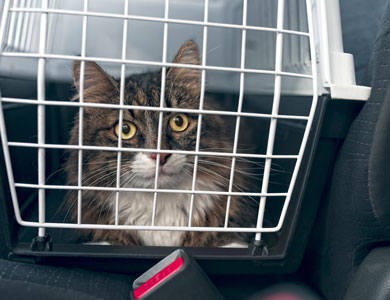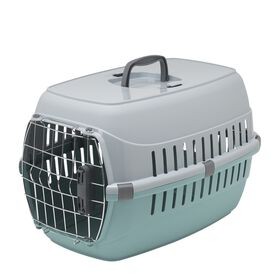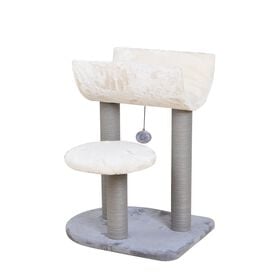Moving time... an exhausting experience for most of us, but for our feline companions, it’s much more than that… For many cats, changing homes represents a very difficult period of their life, and there's no leaving them behind.
Routine and stability of their environment, which are integrated so deeply in their life, are taken away in an instant. They will have to work really hard at creating a new routine with new habits in this new environment.

Before moving
However there are ways to help your cat go through this transition period more easily. This is particularly important if you have an older cat who has never experienced changes in its environment, or if your cat is the fearful type.
Packing boxes
Try to group the boxes in the same place, if possible. By stacking them high, you offer your cat a new playground. Most cats also love empty cardboard boxes, so don't hesitate to place a few on the floor, hiding toys or treats. This will give Kitty a place to hide, and the boxes that accumulate in his environment will be seen in a more positive light.
Identification
If you haven't already done so, update his ID tag and microchip data with the correct information. You should also find out which shelter or pound is responsible for your area, as this information will come in handy if your cat runs away during the move.
The daily routine
Try to maintain a regular routine for your cat, even if you're busy preparing for the move. Give him his meals at the usual times, and continue to make time for play and affection. These cues will help him to better accept the changes in his environment. For the same reason, don't put away his things (cat tree, cushion, toys) until you're ready to leave, so he can have access to them for as long as possible.
The cat's scent
A few days before moving, put some towels or blankets in your cat's favorite spots. He will lay on them and leave his odour at the same time. The day before the move, take these pieces of cloth and rub them on the lower part of the walls of your new place. When your pet arrives at its new home, it will feel as if he has already been there, as its scent will permeate the place.
Moving day
It's the big day! Here's what you can do to make sure the move goes smoothly for your cat.
Isolation = security
The day of the move, isolate your cat (in your old house and your new home), in a room where he will be cut off from the noise and the movers while furniture and boxes are being moved around. Choose a quiet room like a bathroom, as opposed to a living room or a bedroom.
In his isolation room, place his litter box in one corner and his food and water bowl in the opposite corner or on the counter (if your cat can climb it). Offer him food he likes, or his favorite treats. Adding new toys can also help reduce stress both during and after the move, and will help associate the new environment with a positive experience.

Transportation
If your cat doesn't like the carrier or isn't used to it, it's best to prepare him in advance so that the car journey is as stress-free as possible. A few weeks before the move, leave the carrier open in the house and place a comfortable blanket and treats in it. The idea is for your cat to enter on its own and realize that it's a pleasant, safe space.
If your cat doesn't cope well with car journeys (vomiting, relieving itself) and you have to do a lot of travelling, consult your vet. They'll be able to advise you on the best options for your cat.
New surroundings
Do not let your cat out of his isolated room until the move is completed, until there are nobody else in the home but the usual members of the family and until most of the furniture is put in place. Definitely do not let your cat out as long as he is not calm. If he remains hidden in a corner of the room, if he crawls on the floor and if he does not eat, this means he is not ready to explore the rest of the house. Wait until he recovers from all the stress and anxiety and adopts a somewhat normal behaviour before letting him loose to discover his new territory. Let him explore at his own pace, room by room, floor by floor.
Settling in your new house
Here's what you need to do to ensure a smooth integration into your new home.
Exploring the house
Some cats might take a few days or even a few weeks to explore this whole new territory. Other cats, more curious and brave, will be very eager to begin this great adventure of exploring this new territory quickly. Most of you know your cat well enough to assess if he will adapt easily or if it will take him longer to adjust to his new surroundings. During this adaptation period, it is important to make sure your cat eats and drinks regularly. If, after 2 days, he has not eaten or drank, you must see a veterinarian doctor quickly. Do not wait until your cat is dehydrated.
When your cat explores, let him do so without following him because if you do, it is as if you were telling him that there might be something potentially dangerous and you want to protect him (at least that’s how kitty will perceive your behaviour). This will obviously not help him adjust. Instead, act normally all the while keeping an eye out for him. Kitty will then think that though his territory has changed, the routine remains relatively the same which will reassure him. Do not push your cat into exploring where he does not want to. Let him do this his own way.

As most cats find security in heights, setting up his cat tree will go a long way to reducing the anxiety associated with this new habitat, especially if you have several cats. Adding disposable litter boxes in different rooms will also help your cat to quickly familiarize itself with its new environment. Add litter grains from your cat's usual litter box, so he can recognize its scent.
Establish a new routine
The faster your new home is reorganized, the better it will be for kitty. Remember that every single time you change something in his territory (your home), he has to adjust again. In the weeks following the move, try not to change too many things in the home to help your cat create his new routine and get accustomed to his new home more quickly.
Taking the time to prepare the arrival of your feline companion in his new home is worth all the time and energy you will invest and he will surely give you back in his own way what you gave him. Happy moving!
Checklist
- If you're moving to a new town, don't forget to check the municipal by-laws concerning animals. Make sure you know how many animals you're allowed and what the requirements are for microchipping and sterilization.
- Finding a new veterinarian can be difficult. Contact the clinics in your new area as soon as you know you're moving to get on the waiting lists. Once you've moved, make an appointment as soon as possible to develop a relationship of trust with your new vet.
- If you're moving to a new region, find out what parasite prevention is needed.
- Pack a small bag with all your cat's essentials. That way, you won't have to search for his bowl or toys in the boxes.
- On moving day, make sure your cat has access to fresh water at all times.








